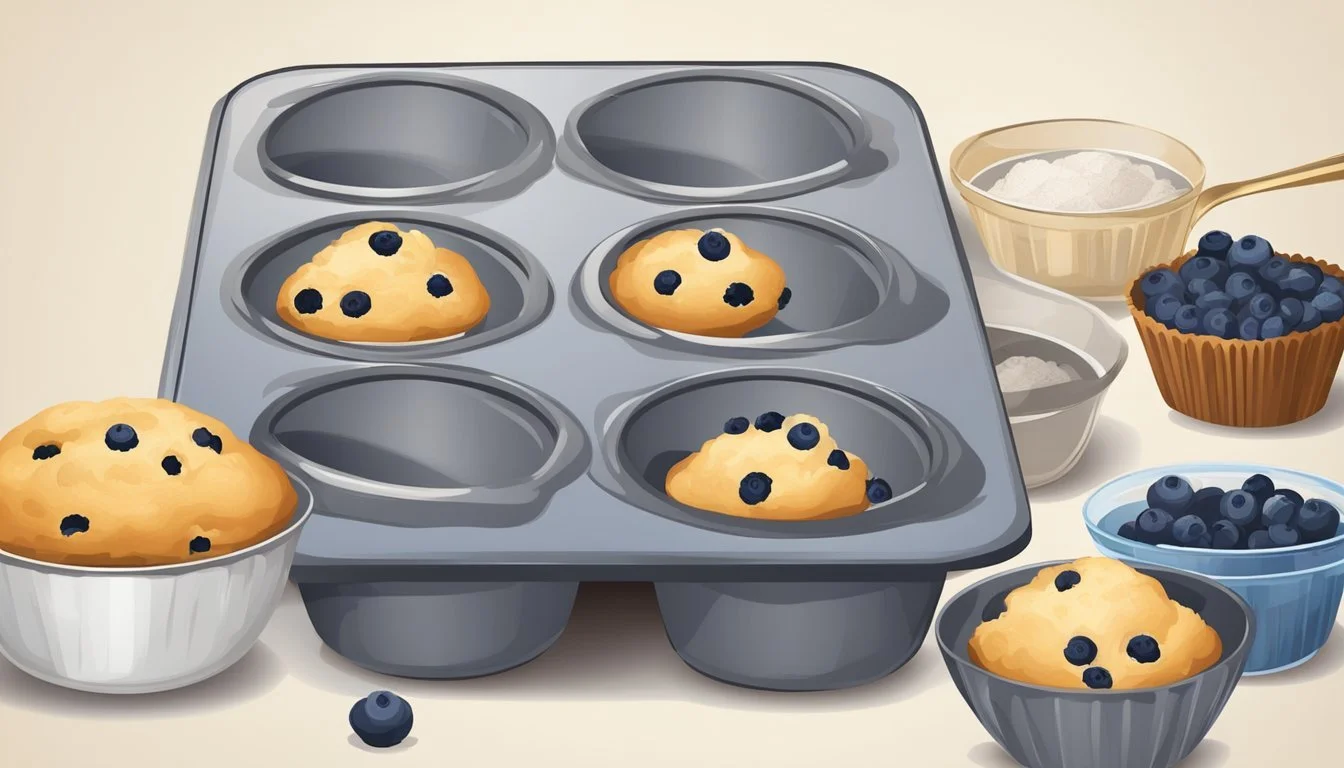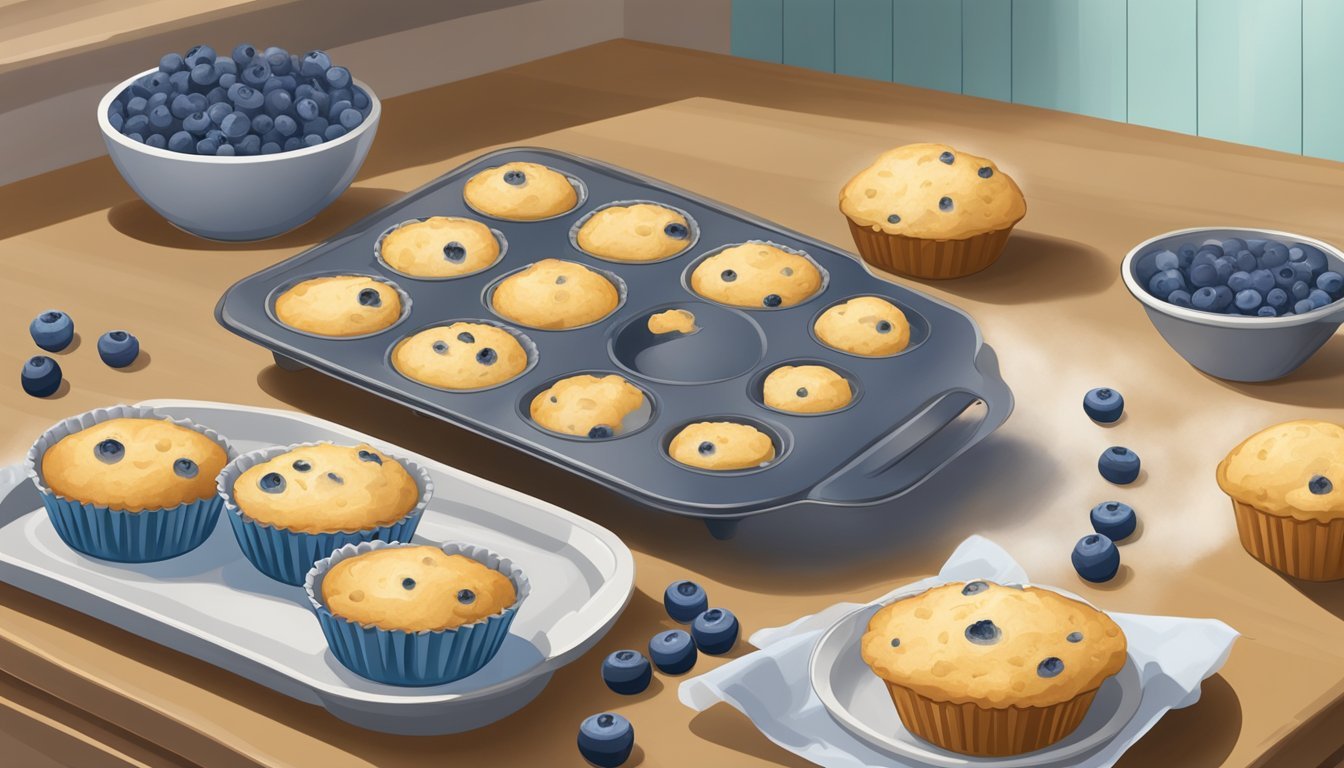How Do You Eat a Blueberry Muffin
Tips for Maximum Enjoyment
Eating a blueberry muffin can be as delightful an experience as baking one. Blueberry muffins are a staple in the world of home baking, offering a perfect blend of sweet and tangy flavors. They are often enjoyed as a quick breakfast option, a snack to pair with afternoon tea, or even as a dessert. The key to an enjoyable blueberry muffin lies in its preparation—using either fresh or frozen blueberries, ensuring that the batter is not overmixed, and baking at the right temperature.
The process begins long before the first bite is taken. Bakers know that a successful blueberry muffin recipe starts with the careful measurement of ingredients. The harmony between flour, sugar, baking powder, and salt creates the structural base, which is then enriched with a combination of wet ingredients such as eggs, oils, or butters to add moisture and flavor. Some recipes call for additional ingredients like sour cream or yogurt, which provide a tenderness to the crumb. Each ingredient must be incorporated gently to keep the muffins soft and moist rather than dense and dry.
When it comes to the baking process, precision is equally important. Temperature and timing are crucial factors; a common recommendation is a preheated oven at 400 degrees Fahrenheit to ensure that the muffins rise properly and develop a golden crust. Recipes typically advise against baking for more than 20 minutes to prevent overcooking. With careful preparation and attention to these details, the result is a delectable treat with a balance of flavors and textures, ready to be savored in its simplicity.
Choosing Ingredients
The quality and type of ingredients used in baking blueberry muffins directly impact the flavor and texture of the finished product. Selecting the right components is crucial to create a perfect muffin.
Flour Types
In blueberry muffin recipes, all-purpose flour is the most common choice for its versatility and because it provides the right balance of softness and structure. However, some bakers prefer whole wheat flour for a nuttier taste and added fiber.
Selecting Blueberries
Fresh blueberries are ideal for their natural sweetness and vibrant color. Nonetheless, frozen blueberries can also be used; they should not be thawed to prevent the muffins from turning purple. The berries should be firm and mold-free.
Dairy and Eggs
Dairy products add richness and tenderness to muffins. Whole milk or alternatives like buttermilk or sour cream can be employed for enhanced flavor and moisture. Eggs are essential for binding the ingredients together and contributing to the muffin's rise.
Sweeteners
Granulated sugar is typically used for a clean, sweet taste, while brown sugar can be used for a hint of molasses flavor. The amount varies depending on desired sweetness.
Leavening Agents
Baking powder and baking soda are chemical leavening agents that release carbon dioxide and cause the muffins to rise. The right balance of these will ensure a fluffy texture without an aftertaste.
By carefully selecting each of these ingredients, bakers can ensure their blueberry muffins are delicious and of high quality.
Baking Tools and Equipment
For successful blueberry muffin baking, one must prioritize having the proper tools and equipment. The right muffin pan, precise measuring tools, and efficient mixing utensils are integral for baking.
Muffin Pans
A muffin pan, also known as a muffin tin, is essential for shaping and baking muffins. Blueberry muffin recipes typically call for either a standard 12-cup muffin pan or a 24-cup mini muffin pan. These come in various materials, but a nonstick variant can simplify the removal process. Bakers should preheat their oven to the exact temperature specified in the recipe, usually ranging between 350°F to 425°F (175°C to 220°C), for optimal results. For those preferring to minimize cleanup or to ensure easy muffin release, muffin liners can be used, and some bakers might lightly coat these with nonstick cooking spray.
Measuring Equipment
Precise measurement is key to baking. It's advised to have a set of dry measuring cups and spoons, as well as a liquid measuring cup for wet ingredients. To measure out batter consistently, a cookie scoop or an ice cream scoop ensures even sizing and can reduce mess when transferring the batter to the muffin pan.
Mixing Tools
Two primary tools are required: mixing bowls and a device for mixing. A variety of bowl sizes allows for separate preparation of wet and dry ingredients before combining them. A stand mixer can be useful for creaming together ingredients, although a simple whisk or a spatula can suffice for gently folding the blueberries into the batter to prevent breaking. Post-baking, having a wire rack on hand is crucial for cooling the muffins, preventing sogginess by allowing air to circulate underneath.
Preparing the Batter
The preparation of muffin batter is a critical step in creating the perfect blueberry muffin. Mastery of mixing technique and proper combination of ingredients ensures a moist and flavorful result.
Mixing Technique
In the art of baking, the mixing technique is paramount. For muffin batter, a gentle hand is key – one should aim to mix until just combined; overmixing is to be strictly avoided as it can result in a tough texture. Start by whisking the wet ingredients together which typically include eggs, milk, and vanilla extract, ensuring they are well-blended before incorporating into the dry ingredients.
Combining Ingredients
A meticulous approach to combining ingredients is crucial for a well-risen muffin. A standard set of dry ingredients comprises:
All-purpose flour
Baking powder
Baking soda
Salt
These should be sifted together to introduce air and ensure an even distribution which prevents clumping. Separately, cream sugar with butter until light and fluffy to create a foundation of sweetness and moisture. Blueberries are folded in last to minimize breaking and bleeding. It should be noted that coating the blueberries lightly in flour can help suspend them in the batter, preventing them from sinking to the bottom during baking.
Baking the Muffins
When preparing to bake blueberry muffins, precise oven settings and accurate baking duration are crucial for achieving the perfect muffin texture and flavor.
Oven Settings
Most blueberry muffin recipes require the baker to preheat the oven. The temperature for baking can vary slightly, but a common range is between 375°F to 400°F. Some recipes might instruct to start with a higher temperature to help the muffin rise, then lower it to prevent the tops from burning. It's essential for the oven to reach the desired temperature before the muffins are placed inside to ensure even baking.
Baking Duration
Once the oven is preheated, blueberry muffins typically bake for 18 to 25 minutes. The exact time can depend on the muffin size and the specific heat of the oven. Muffins are done when they demonstrate a golden brown color on top and a toothpick or cake tester inserted into the center comes out clean or with a few moist crumbs. Overbaking can lead to dry muffins, so one should keep a close watch as the baking duration approaches its end.
Serving and Presentation
When presenting blueberry muffins, the optimum experience comes from paying attention to the cooling process and selecting accompaniments that heighten their flavors. These steps ensure that muffins are enjoyed at their best whether served at breakfast or brunch.
Cooling and Removing
Blueberry muffins should be removed from their baking tin immediately after baking. This prevents them from becoming soggy by allowing steam to escape. They should rest on a cooling rack for a comfortable touch before serving. The perfect blueberry muffin is bakery-style with a golden-brown top and a light, airy inside, so proper cooling is essential to maintain this delicate texture.
Serving Suggestions
Blueberry muffins can stand alone or be enhanced with various pairings. For a hearty breakfast, accompany muffins with vanilla yogurt for a creamy texture and a balance to the sweetness. Adding fresh fruit can create a vibrant plate and increase nutritional value. When serving at brunch, offer coffee to complement the muffins' rich flavor. Muffins can also be sliced and toasted with a pat of butter for a warm treat. For those aiming to impress at a family gathering or looking for an Instagram-worthy presentation, serve the muffins on a stylish platter or a rustic wooden board to add a visual appeal.
Storage and Shelf Life
Proper storage is crucial for maintaining the freshness and flavor of blueberry muffins. Whether one opts for short-term enjoyment or long-term preservation, understanding the right conditions and methods is key.
Short-Term Storage
For those planning to enjoy their blueberry muffins within a brief period, it's advisable to store them at room temperature. An airtight container is paramount to prevent moisture loss and to keep the muffins moist. Ideally, muffins should be consumed within 1-2 days when stored on the countertop. In hotter and more humid environments, one must be vigilant as these conditions can shorten a muffin's shelf life.
Freezing and Long-Term Preservation
When it comes to extending the shelf life of blueberry muffins, freezing is a highly effective method. Muffins are freezer-friendly and can be stored in the freezer for up to three months. Prior to freezing, each muffin should be wrapped individually in plastic wrap or aluminum foil, and then placed in a freezer bag. This helps prevent freezer burn and flavor contamination. To thaw, the muffins should be removed from the freezer and allowed to come to room temperature, which ensures they retain their original texture and taste.
Health and Nutrition
When considering the consumption of blueberry muffins, one must assess their nutritional value and how they fit into a dietary plan. These baked goods often walk a fine line between being a comforting treat and a source of significant caloric intake.
Dietary Considerations
Blueberry muffins can vary widely in their nutritional composition based on the ingredients used. A typical coffee shop blueberry muffin may contain around 470 calories, with the majority stemming from refined carbohydrates such as white flour and sugar. In contrast, healthier versions may incorporate whole wheat or almond flours, reducing the calorie count and improving the nutrient profile.
Nutritional Components of a Blueberry Muffin (Approximate Values):
Calories: 200-470 calories per muffin
Protein: 1-5 grams, depending on the flour and additives
Fat: 0-20 grams, influenced by the use of oil or butter
Carbohydrates: 20-60 grams, with healthier options featuring more complex carbs
Fiber: 1-4 grams, higher if whole grains are used
Vitamin C: The blueberries contribute to the vitamin C content
Vitamin A, Calcium, Iron: Present in small amounts, varying with ingredients like eggs or enriched flours
It's crucial for individuals to understand the macro and micronutrient distribution in these muffins, which directly impacts energy levels and overall well-being. For those looking to maintain a balanced diet, opting for a blueberry muffin that's rich in fiber and low in refined sugar can make for a more nutritious snack. Regular blueberries themselves are known to be high in antioxidants, but when added to muffins, their benefits are often overshadowed by sugars and fats. Therefore, one should assess the portion size and ingredients to ensure that it is aligned with their health goals.
Variations and Substitutions
When personalizing a blueberry muffin recipe, one can explore a variety of fruit variants and make dietary adjustments without compromising the integrity of the classic treat. These changes can cater to personal taste preferences or specific dietary needs.
Fruit Variants
Fresh vs. Frozen Berries: Traditional blueberry muffins often call for fresh blueberries, but frozen berries can be a convenient substitute. For those looking to experiment, banana muffins or zucchini muffins offer a delightful twist. Alternatively, lemon blueberry muffins provide a tangy zest which complements the sweetness of blueberries.
Implementing Fruit Variants:
Blueberries: Use fresh blueberries for a burst of flavor or opt for frozen blueberries if out-of-season; no need to thaw.
Bananas: (how long do bananas last?) Mash ripe bananas to incorporate into your muffin batter for a moist, flavorful variant.
Zucchini: Grate zucchini and squeeze out excess moisture before adding it to the muffin mix.
Lemon: Mix in lemon zest for an aromatic citrus note in lemon blueberry muffins.
Dietary Adjustments
Gluten-free and Alternative Flours: For those with dietary restrictions, using gluten-free flour blends can make blueberry muffins accessible. Substitutions like almond or oat flour may require adjustments in ratios and could introduce unique flavors and textures.
Sweetener and Fat Substitutes:
Sugar Alternatives: Honey or maple syrup can replace granulated sugar, often resulting in a more nuanced sweetness.
Oil and Butter: Applesauce or yogurt can substitute for oil or butter to decrease fat content while maintaining moisture.
Toppings and Additions:
Crumb or Streusel Topping: A streusel topping, with or without oats, can add a delectable crunch to your muffin tops.
Glaze: A simple confectioners' sugar glaze or lemon juice mixture can dress up muffins for a sweet finish.
Adjustments Table:
Substitute Suggested Ratio Notes Gluten-free flour As per product instructions May need xanthan gum if not included. Almond flour 1:1 substitution, increase egg Absorbs more moisture. Frozen berries Equal measure Do not thaw to prevent colors from bleeding. Honey/Maple Syrup ¾ cup for 1 cup sugar Reduce liquid in recipe by 2-4 tbsp. Applesauce/Yogurt 1 cup for 1 cup butter Use unsweetened applesauce to reduce sugar.
These modifications offer bakers the flexibility to innovate on the classic blueberry muffin, whether the goal is to incorporate different fruits or to adapt the recipe to meet dietary needs. Each substitution provides its own unique qualities, allowing for a custom muffin experience while maintaining the essence of the beloved original.
Tips and Tricks
To master the art of making the perfect blueberry muffin, focusing on texture and flavor is key, as well as creating the ideal topping to complement the muffin's taste and visual appeal.
Improving Texture
To achieve a moist blueberry muffin, the baker should consider the mixing method and baking time. One should mix the batter just until combined to keep the muffins soft. Overmixing can lead to a dense, tough muffin. Homemade blueberry muffins benefit from a gentle fold of flour-coated blueberries into the batter to distribute them evenly without breaking. The flour coating prevents the berries from sinking during baking.
Proper mixing technique: Stir until just combined.
Flour-coated blueberries: Gently fold into batter.
Enhancing Flavor
A flavor-packed homemade blueberry muffin comes from the quality of the ingredients and additions that complement the main star—blueberries. A dash of almond extract can introduce a nutty depth to the muffin recipes, while fresh or frozen blueberries lead to a more intense berry flavor in each bite. Those seeking an easy to make but flavorful variation might substitute lemon zest for cinnamon to provide a subtle, citrusy note.
Almond extract: Adds nutty depth.
Fresh/Frozen blueberries: Intensify berry flavor.
Cinnamon or lemon zest: Subtle, complementary notes.
Creating Toppings
The crown of a blueberry muffin can be graced by a streusel or crumb topping, offering a contrasting texture and added flavor. A simple streusel topping made with all-purpose flour, cinnamon, honey, and walnut pieces not only enhances the taste but also adds a delightful crunch. Bakers might opt for a sprinkle of raw sugar before baking for a simpler, yet sparkly finish.
Streusel topping:
Ingredients Quantity All-purpose flour 1 cup Cinnamon 1 tsp Honey to taste Chopped walnuts 1/2 cup
Raw sugar sprinkle: A simple alternative for a crispy top.
Online Resources and Social Sharing
The advent of digital media has transformed how one finds and shares culinary experiences. Enthusiasts now have an abundance of resources online to locate bakery-style blueberry muffin recipes and are able to share their homemade creations with family and friends through social platforms.
Finding Recipes Online
When seeking free recipes for blueberry muffins from scratch, individuals often turn to cooking blogs and websites that offer a plethora of options, each with detailed instructions and the possibility of finding substitutions for specific ingredients. Websites provide a rating system allowing users to discern the quality of the recipe based on others' experiences.
Instagram and YouTube: Offer visual inspiration through photos and videos, showcasing the texture and presentation of muffins.
Newsletters: Many food bloggers and culinary websites offer newsletters that share exclusive recipes and tips.
Recipes found online often encourage bakers to tweak ingredients to suit personal tastes or dietary restrictions, emphasizing the importance of trying variations until one finds their perfect match.
Sharing Creations
After baking, individuals enjoy showcasing their bakery-fresh muffins on social media. They may write a post detailing their experience or even share a video of the baking process.
Instagram: A popular platform for sharing images of food, where users can use hashtags to reach a wider audience interested in baking. Photos can show step-by-step processes or the final product.
Family and Friends: Social networks enable the sharing of recipes and pictures with loved ones, making it easy to inspire or be inspired by the baking endeavors of others.
Sharing extends beyond mere imagery; it's about connecting through a shared passion for baking, where every like or comment serves as a form of encouragement or feedback.









